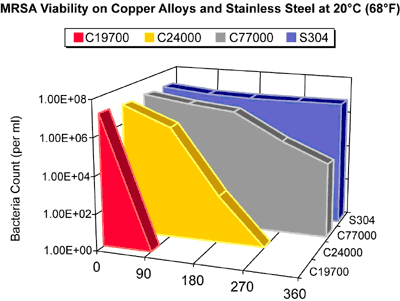May 24, 2004
FOR IMMEDIATE RELEASE
NEW YORK- A new study holds promise for stemming MRSA contamination by using copper alloys for surfaces in healthcare facilities. Doctors C. William Keevil and J.O. Noyce of the University of Southampton, U.K., reported the study here today at a meeting of the American Society for Microbiology.
Methicillin resistant Staphylococcus aureus is a virulent organism, essentially resistant to all ß-lactam antibiotics (e.g., penicillins, ampicillins, cephalosporins). MRSA, one of the so-called "superbugs," can cause skin, bone and life-threatening blood infections, as well as pneumonia. It occurs commonly among persons in hospitals and healthcare facilities, where it is typically transmitted by medical staff, patients and by contact with heavily contaminated equipment and environmental surfaces around infected patients.
According to the U.S. Centers for Disease Control and Prevention, nosocomial infections are the fourth leading cause of death in the United States, after heart disease, cancer and strokes. MRSA ranks as the nation's second most antimicrobial-resistant infection, with its highest incidence in Intensive Care Units, followed by non-ICU inpatient areas.
The study compared the survival rates of the often-deadly bacteria on stainless steel, the most commonly used metal in healthcare facilities, and on selected copper alloys. At room temperature, MRSA was able to persist and remain viable in dried deposits on stainless steel (C304) for periods up to 72 hours. For copper alloys - C77000 (55% copper), C24000 (80% copper) and C19700 (99% copper) - significant reductions in viability were achieved after 4.5 hours, 3 hours and 1.5 hours, respectively. The yellow brass rendered the bacteria completely inviable after 270 minutes, while the high-copper alloy took only 90 minutes.
 Graph depicts survival times of Methicillin Resistant Staphylococcus aureus on three copper alloys and stainless steel (C304) at room temperature. C19700 (99% copper) limited survival to 1.5 hours. C24000 (80% copper) showed a significant reduction after 3 hours and complete inviability after 4.5 hours. C77000 (55% copper) showed significant and continuing reduction after 4.5 hours. Survival time on stainless steel continued up to 72 hours.
Graph depicts survival times of Methicillin Resistant Staphylococcus aureus on three copper alloys and stainless steel (C304) at room temperature. C19700 (99% copper) limited survival to 1.5 hours. C24000 (80% copper) showed a significant reduction after 3 hours and complete inviability after 4.5 hours. C77000 (55% copper) showed significant and continuing reduction after 4.5 hours. Survival time on stainless steel continued up to 72 hours.Dr. Keevil said the study strongly indicates that use of the copper metals in such applications as door knobs, push plates, fittings, fixtures and work surfaces would considerably mitigate MRSA in hospitals and reduce the risk of cross-contamination between staff and patients in critical care areas. He also explained that, despite the significant performance of copper alloys in this study, the survivability of MRSA on all metals at lower temperatures (39°F/4°C) is much greater, indicating that heightened hygiene is particularly imperative in those environments.
Keevil added that the antimicrobial effects of copper have been well documented. He cited recent studies on E. coli O157 and Listeria monocytogenes on copper alloy surfaces that show similar dramatic results, reducing viability of those pathogens from several weeks on stainless steel to only a matter of hours on copper alloys.
The MRSA study is co-funded by the International Copper Association and Copper Development Association Inc., New York, and managed by CDA.
Dr. Harold Michels, CDA vice president of technical services, said the study clearly shows that "the use of stainless steel in hospital environments for work surfaces and door furniture is potentially exacerbating an already critical situation with regards to MRSA transmission and infection." Michels stressed the desirability for the healthcare industry to evaluate and to begin using copper alloy hardware and surfaces, especially in high human-contact areas.
A copy of the study report, "The Antimicrobial Effect of Copper and Copper-based Alloys on Methicillin Resistant Staphylococcus aureus," may be obtained by contacting CDA.
###
